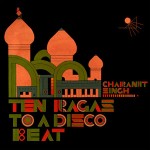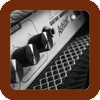|
|
 |
Dusted Reviews
Artist: Charanjit Singh Album: Synthesizing: Ten Ragas to a Disco Beat Label: Bombay Connection Review date: Jan. 3, 2011 |

|
|
|
 |
Last widely heard in this hemisphere on several tracks from Sublime Frequencies’ excellent Bollywood Steel Guitar compilation, Charanjit Singh offers here a fusion of Moroder-esque disco and traditional raga from 1982 that -- in historical context -- probably blew a good many fewer minds back then. The press and liner notes tout this record as an eerily prescient isolate, a 303- and 808-driven artifact that could well have been a blueprint for acid house as it later evolved halfway around the world. Perhaps so, but Synthesizing… stands more than well enough on its own as a demonstration of how Hindustani raga can capture the imagination regardless of the instrumentation used to render it.
This is a minimalist record indeed, but with a complexity hidden among the flurries of notes that reveals itself only after repeated listens. The hypnotic, chittering pulse of Singh’s Roland TR-808 drum machine barely changes from track to track, forgoing at least one important characteristic of the typical raga: the subtle rhythmic interplay among the percussionist and the other instrumentalists, as well as the highly regimented beat-cycles. Likewise, the basslines -- generated by the Roland TB-303, a sketchpad-simple electronic bass sequencer that would all but later define the sound of acid house -- stick to the rudimentary. Over that dead-simple foundation, Singh layers squelchy, filtered countermelodies and warbling leads using fat analog tones from a Roland Jupiter-8 synthesizer. Singh being classically trained, the melodies are authentic raga -- haunting and vertiginous over most of the album save for the “major-key” sound of “Raga Bhupali” and “Raga Kalavati,” the latter set to a playful shuffle. Fans of Omar Souleyman’s data-dump keyboard accompaniment might appreciate these similar affectations of Singh, especially when he switches from a round lead synth voice to a harsher tone not unlike the sound produced by the Indian shehnai.
And it’s obvious that Singh was having some fun with the modified compositional palette his collection of gadgets offered: “Raga Megh Malhar” commences with a startling, synthesized thunderclap (keep your volume at a minimum) and the emulated cooing of a peacock. He uses a vocoder effect to intone a Hindu choral chant on “Raga Bhairavi,” and simulates twittering of birds for the morning-raga “Raga Todi” (shades of Kraftwerk’s “Morganspaziergang”?).
It is remarkable testament to his own musicianship that Singh recorded these selections in one take, recording all instruments at once. This and other facts about the man and his music are reviewed in Edo Bouman’s reverent and well-researched notes, which chronicle his own rediscovery of the record in an Indian shop, and his subsequent meeting with the humble Singh himself (astounding considering his prominent role in popularizing the use of electronic instruments in 1970s-’80s Bollywood film music).
By Adam MacGregor
|







